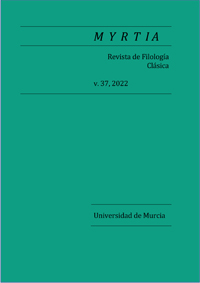Calirrhoe in the dung. On POxy. XIV 1761
Abstract
This paper offers a study of POxy. XIV 1761, which constitutes a private letter. We begin by analyzing its language, its prosopographic and realia aspects and afterwards we focus on the expression “τὰ κόπρια”, which has been considered as an unicum in the Greek papyri. We offer a commentary and translation of this expression, and prefer a scatological metaphorical interpretation of it.
Downloads
-
Abstract952
-
PDF (Español (España))537
References
R. Bagnall, 2011, The Oxford Handbook of Papyrology, Oxford.
R. Bagnall y R. Cribiore, 2008, Women's letters from ancient Egypt (300 BC AD 800), Michigan.
W. Bauer y K. Aland, 1988, Griechisch-deutsches Wörterbuch zu den Schriften des Neuen Testaments und der frühchristlichen Literatur, Berlín.
R. Beekes, 2010, Etymological Dictionary of Greek, Leiden.
J. Bergua, 1945, Refranero español, Madrid.
Y. Broux, 2015, “Graeco-Egyptian Naming Practices: A Network Perspective”, GRBS 55, pp. 706-720.
A. Bülow-Jacobsen, 2013, Communication, travel, and transportation in Egypt’s Eastern Desert during Roman times (1st to 3rd century AD), Köln.
P. Chantraine, 1977, Dictionnaire étymologique de la langue grecque. Histoire des mots, París.
W. Clarysse, 1993, “Egyptian Scribes writing Greek”, CE 68, pp. 186 – 201.
J. Cromwell, 2018, Scribal Repertoires in Egypt from the New Kingdom to the Early Islamic Period. Oxford studies in ancient documents, Oxford.
W. Davis, 1933, Greek Papyri of the First Century, Chicago.
M. Depauw, 2017, “Roman influence on rituals of identification in Egypt”, en Imperial Identities in the Roman World, W. Vanaker and A. Zuiderhoek (eds.), Londres.
E. Dickey, 2011, “The Greek and Latin languages in Papyri”, en The Oxford Handbook of Papyrology, R. S. Bagnall (ed), Oxford, pp. 156 – 177.
T. V. Evans, 2010, The language of the Papyri, Oxford.
F. J. Exler, 1976, The form of the ancient Greek letter of the epistolary papyri, Chicago.
J. C. Fernández Corte, y J. A. González Iglesias, 2006, Catulo. Poesías, Madrid.
D. Foraboschi, 1971, Onomasticon alterum papyrologicum, Milán.
H. Frisk, 1960, Griechisches etymologisches Wörterbuch, Heidelberg.
F. T. Gignac, 1976, A Grammar of the Greek Papyri of the Roman and Byzantine Periods, Milán.
B. Grenfell y A. Hunt, 1920, The Oxyrhynchus Papyri. Part XI, Londres.
P. M. Head, 2019, “Epistolary greetings in the Oxyrrhynchus Papyri”. Tyndale Bulletin. 70, pp. 269-290.
J. Henderson, 1991, The maculate Muse. Obscene language in Attic Comedy, Oxford.
T. Hägg y B. Utas, 2003, “The Virgin and Her Lover. Fragments of an Ancient Greek Novel and a Persian Epic Poem”. Brill Studies in Middle Eastern Literatures. 30, p. 278.
A. S. Hunt y C.C. Edgar, 1970, Select Papyri I, Londres.
D. Laporte, 1993, History of Shit, Massachusetts.
H. G. Liddell, Scott y Jones, 1996, A Greek-Englis lexicon, Oxford.
E. Mayser, 1970, Syntax der Griechischen Papyri aus der Ptolemäerzeit, Berlín.
D. Monserrat, 1963, Sex and Society in Graeco-Roman Egypt, Londres.
J. H. Moulton, y G. Milligan, 1915, The Vocabulary of the Greek Testament, Londres.
F. Preisigke, 1925, Wörterbuch der griechischen Papyrusurkunden, Munich.
B. Puech, 2002, Orateurs et sophistes grecs dans les inscriptions d´ époque impériale, París.
J. Rowlandson y R. Bagnall, 2009, Women and society in Greek and Roman Egypt, Cambridge.
C. Ruiz-Montero, 2017, “Observaciones sobre la recepción del drama antiguo en Caritón de Afrodisias”, SPhV 18, pp. 385-402.
M. Sanz Morales, 2020, Chariton of Aphrodisias´ Callirhoe. A critical edition, Heidelberg.
A. Sarri, 2018, Material aspects of letter writing in the Graeco-Roman world, Berlín.
D. Thompson, 2012, Memphis under the Ptolemies, Princeton y Oxford.
S. Tilg, 2010, Chariton of Aphrodisias and the Invention of the Greek Love Novel, Oxford.
S. Vinson, 2009, “The Names “Naneferkaptah,” “Ihweret,” and “Tabubue” in the “First Tale of Setne Khaemwas”, JNES 47, pp. 283-304.
Sitios web
LGPN (s. f.), Recuperado el 21 de febrero de 2021, de http://www.lgpn.ox.ac.uk/
Oxyrhynchus Online (s. f.). Recuperado el 20 de enero de 2021, de http://163.1.169.40/cgi-bin/librarysite=localhostya=pyp=aboutyc=POxyyct=0yl=enyw=utf-8
Papyri.info. (s. f.), Recuperado 12 de agosto de 2021, de http://papyri.info/
Trismegistos Home (s. f.), recuperado 26 de marzo de 2021, de https://www.trismegistos.org/index.php
Las obras que se publican en esta revista están sujetas a los siguientes términos:
1. El Servicio de Publicaciones de la Universidad de Murcia (la editorial) conserva los derechos patrimoniales (copyright) de las obras publicadas, y favorece y permite la reutilización de las mismas bajo la licencia de uso indicada en el punto 2.
2. Las obras se publican en la edición electrónica de la revista bajo una licencia Creative Commons Reconocimiento-NoComercial-SinObraDerivada 3.0 España (texto legal). Se pueden copiar, usar, difundir, transmitir y exponer públicamente, siempre que: i) se cite la autoría y la fuente original de su publicación (revista, editorial y URL de la obra); ii) no se usen para fines comerciales; iii) se mencione la existencia y especificaciones de esta licencia de uso.
3. Condiciones de auto-archivo. Se permite y se anima a los autores a difundir electrónicamente las versiones pre-print (versión antes de ser evaluada) y/o post-print (versión evaluada y aceptada para su publicación) de sus obras antes de su publicación, ya que favorece su circulación y difusión más temprana y con ello un posible aumento en su citación y alcance entre la comunidad académica. Color RoMEO: verde.





